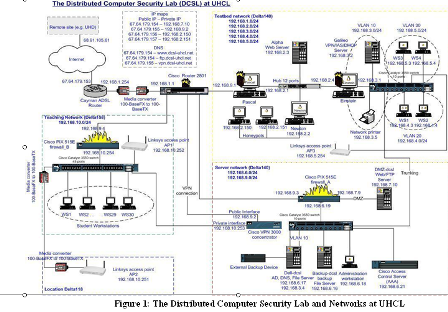|
|
|
|
|
|
·
Disclaimer:
Modules listed below were part of the outcomes of the NSF-sponsored grants,
DUE 0311592 and DUE 0633469, which were collaborative projects between UH
Clear Lake and University of Houston Downtown and Lamar University (DUE
0633445), respectively.
|
|
Network Security Projects
Wireless Sensor Networks
(WSN)
WSN course modules
|
|
"Module-Based Computer
Security Courses" and "Laboratory for Small and Medium Sized
Universities" were collaborative proposals
with Kwok-Bun Yue, George Collins, Morris Liaw, and Ping Chen (UHD). They
were submitted to and funded by the National Science Foundation CCLI A&I
(Adaptation & Instrumentation) program in December 2002. The completion
of the same was marked in 2006. The project team has worked on designing
network prototypes, studying the various equipments (servers, routers,
switches, etc.), investigating Internet connectivity options (mainly DSL),
developing the network architecture, deploying the networks, and developing
lab projects related to various topics about computer and network security.
|
|
|
|
NETWORK SECURITY PROJECTS
|
|
|
|
|
|
|
PROJECT DESCRIPTION
|
|
|
|
The major
component is designing a Distributed Computer Security Lab (DCSL) across two
campuses of the University of Houston (UH) System, UH-Clear Lake and
UH-Downtown. The network diagram in Figure 1 illustrates the architecture of
the Lab developed at UHCL.
|
|
|
|

|
|
|
|
* Click on the
image to enlarge
|
|
|
|
Beginning in
June 2003, T. Andrew Yang has led the team of five UHCL/UHD faculty members
and several graduate students in designing computer security laboratories and
courseware modules. The project team has worked on designing network
prototypes, studying the various equipments (servers, routers, switches,
etc.), investigating Internet connectivity options (mainly DSL), developing
the network architecture, deploying the networks, and developing lab projects
related to various topics about computer and network security. The first two
years of the project have successfully produced a prototype network, a server
network, a teaching classroom, and several computer security lab modules. The
project was extended for one more year in order to complete the wireless
network and VPN (virtual private network) projects. Overall there have been
eight student assistants and five faculty members working on the project, and
over 90 students have used the developed labs in doing research and/or
completing their Network Security and Web Security class projects.
|
|
|
|
|
|
|
|
|
|
|
|
LAB DEVELOPMENT (ADDITIONAL
INFORMATION)
|
|
|
|
Top
|
|
|
|
|